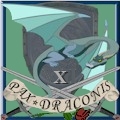lolwiki wrote:
Captain Robert Pearson and First Officer Maurice Quintal at the controls. At 41,000 feet (12,500 m), over Red Lake, Ontario, the aircraft's cockpit warning system sounded,... A few moments later, a second fuel pressure alarm sounded, prompting the pilots to divert to Winnipeg. Within seconds, the left engine failed and they began preparing for a single-engine landing.
As they communicated their intentions to controllers in Winnipeg and tried to restart the left engine, the cockpit warning system sounded again, this time with a long "bong" that no one present could recall having heard before. This was the "all engines out" sound, an event that had never been simulated during training. Seconds later, most of the instrument panels in the cockpit went blank as the right-side engine also stopped and the 767 lost all power.
The 767 was one of the first airliners to include an Electronic Flight Instrument System (EFIS). [Without engines the 767 had no electricity for most of the flight instruments, and no hydraulic power for the wing flaps, tail slat, and wheels.The pilots were left with enough basic instruments to land the craft, but not enough to fly it or know their speed of descent. They had an emergency ram air turbine to kind of run the hydraulics, but it loses power the more the aircraft needs to slow to land. The closer to landing, the less control the pilots have.]
In line with their planned diversion to Winnipeg, the pilots were already descending through 35,000 feet when the second engine shut down. They immediately searched their emergency checklist for the section on flying the aircraft with both engines out, only to find that no such section existed. Captain Pearson, however, was an experienced glider pilot, which gave him familiarity with some flying techniques almost never used by commercial pilots. [lucky a practising glider pilot was aboard!] In order to have the maximum range and therefore the largest choice of possible landing sites, he needed to fly the 767 at the "best glide ratio speed". Making his best guess as to this speed for the 767, he flew the aircraft at 220 knots. First Officer Maurice Quintal began making calculations to see if they could reach Winnipeg. He used the altitude from one of the mechanical backup instruments, while the distance travelled was supplied by the air traffic controllers in Winnipeg, measuring the distance the aircraft's echo moved on their radar screens. The aircraft had lost 5,000 feet in 10 nautical miles giving a glide ratio of approximately 12:1. The controllers and Quintal both calculated that Flight 143 would not make it to Winnipeg.
At this point, Quintal proposed landing at the former RCAF Station Gimli, a closed air force base where he had once served as a Canadian Air Force pilot. Unknown to him, however, part of the facility had been converted to a race track complex, now known as Gimli Motorsports Park. It includes a road race course, a go-kart track, and a dragstrip. Furthermore, a CASC amateur sports car race was underway that day and the area around the decommissioned runway was full of cars and campers. Part of the decommissioned runway itself was being used to stage the race.
Without power, the pilots had to try lowering the aircraft's main landing gear via a gravity drop, but, due to the airflow, the nose wheel failed to lock into position. The decreasing forward motion of the aircraft also reduced the effectiveness of the ram air turbine, making the aircraft increasingly difficult to control because of the reduced power being generated.
As the runway drew nearer, it became apparent that the aircraft was too high and fast, raising the danger of running off the runway before the aircraft could be stopped. The lack of hydraulic pressure prevented flap/slat extension. These devices are used under normal landing conditions to reduce the stall speed of the aircraft for a safe landing. The pilots briefly considered executing a 360 degree turn to reduce speed and altitude, but decided that they did not have enough altitude for the maneuver. Pearson decided to execute a forward slip to increase drag and lose altitude. This maneuver is commonly used with gliders and light aircraft to descend more quickly without gaining forward speed.
As soon as the wheels touched the runway, Pearson "stood on the brakes", blowing out two of the aircraft's tires. The unlocked nose wheel collapsed and was forced back into its well, causing the aircraft's nose to scrape along the ground. The plane also slammed into the guard rail now separating the strip, which helped slow it down.
None of the 61 passengers were seriously hurt. A minor fire in the nose area was extinguished by racers and course workers armed with fire extinguishers. As the aircraft's nose had collapsed onto the ground, its tail was elevated and there were some minor injuries when passengers exited the aircraft via the rear slides, which were not long enough to accommodate the increased height.
As they communicated their intentions to controllers in Winnipeg and tried to restart the left engine, the cockpit warning system sounded again, this time with a long "bong" that no one present could recall having heard before. This was the "all engines out" sound, an event that had never been simulated during training. Seconds later, most of the instrument panels in the cockpit went blank as the right-side engine also stopped and the 767 lost all power.
The 767 was one of the first airliners to include an Electronic Flight Instrument System (EFIS). [Without engines the 767 had no electricity for most of the flight instruments, and no hydraulic power for the wing flaps, tail slat, and wheels.The pilots were left with enough basic instruments to land the craft, but not enough to fly it or know their speed of descent. They had an emergency ram air turbine to kind of run the hydraulics, but it loses power the more the aircraft needs to slow to land. The closer to landing, the less control the pilots have.]
In line with their planned diversion to Winnipeg, the pilots were already descending through 35,000 feet when the second engine shut down. They immediately searched their emergency checklist for the section on flying the aircraft with both engines out, only to find that no such section existed. Captain Pearson, however, was an experienced glider pilot, which gave him familiarity with some flying techniques almost never used by commercial pilots. [lucky a practising glider pilot was aboard!] In order to have the maximum range and therefore the largest choice of possible landing sites, he needed to fly the 767 at the "best glide ratio speed". Making his best guess as to this speed for the 767, he flew the aircraft at 220 knots. First Officer Maurice Quintal began making calculations to see if they could reach Winnipeg. He used the altitude from one of the mechanical backup instruments, while the distance travelled was supplied by the air traffic controllers in Winnipeg, measuring the distance the aircraft's echo moved on their radar screens. The aircraft had lost 5,000 feet in 10 nautical miles giving a glide ratio of approximately 12:1. The controllers and Quintal both calculated that Flight 143 would not make it to Winnipeg.
At this point, Quintal proposed landing at the former RCAF Station Gimli, a closed air force base where he had once served as a Canadian Air Force pilot. Unknown to him, however, part of the facility had been converted to a race track complex, now known as Gimli Motorsports Park. It includes a road race course, a go-kart track, and a dragstrip. Furthermore, a CASC amateur sports car race was underway that day and the area around the decommissioned runway was full of cars and campers. Part of the decommissioned runway itself was being used to stage the race.
Without power, the pilots had to try lowering the aircraft's main landing gear via a gravity drop, but, due to the airflow, the nose wheel failed to lock into position. The decreasing forward motion of the aircraft also reduced the effectiveness of the ram air turbine, making the aircraft increasingly difficult to control because of the reduced power being generated.
As the runway drew nearer, it became apparent that the aircraft was too high and fast, raising the danger of running off the runway before the aircraft could be stopped. The lack of hydraulic pressure prevented flap/slat extension. These devices are used under normal landing conditions to reduce the stall speed of the aircraft for a safe landing. The pilots briefly considered executing a 360 degree turn to reduce speed and altitude, but decided that they did not have enough altitude for the maneuver. Pearson decided to execute a forward slip to increase drag and lose altitude. This maneuver is commonly used with gliders and light aircraft to descend more quickly without gaining forward speed.
As soon as the wheels touched the runway, Pearson "stood on the brakes", blowing out two of the aircraft's tires. The unlocked nose wheel collapsed and was forced back into its well, causing the aircraft's nose to scrape along the ground. The plane also slammed into the guard rail now separating the strip, which helped slow it down.
None of the 61 passengers were seriously hurt. A minor fire in the nose area was extinguished by racers and course workers armed with fire extinguishers. As the aircraft's nose had collapsed onto the ground, its tail was elevated and there were some minor injuries when passengers exited the aircraft via the rear slides, which were not long enough to accommodate the increased height.



